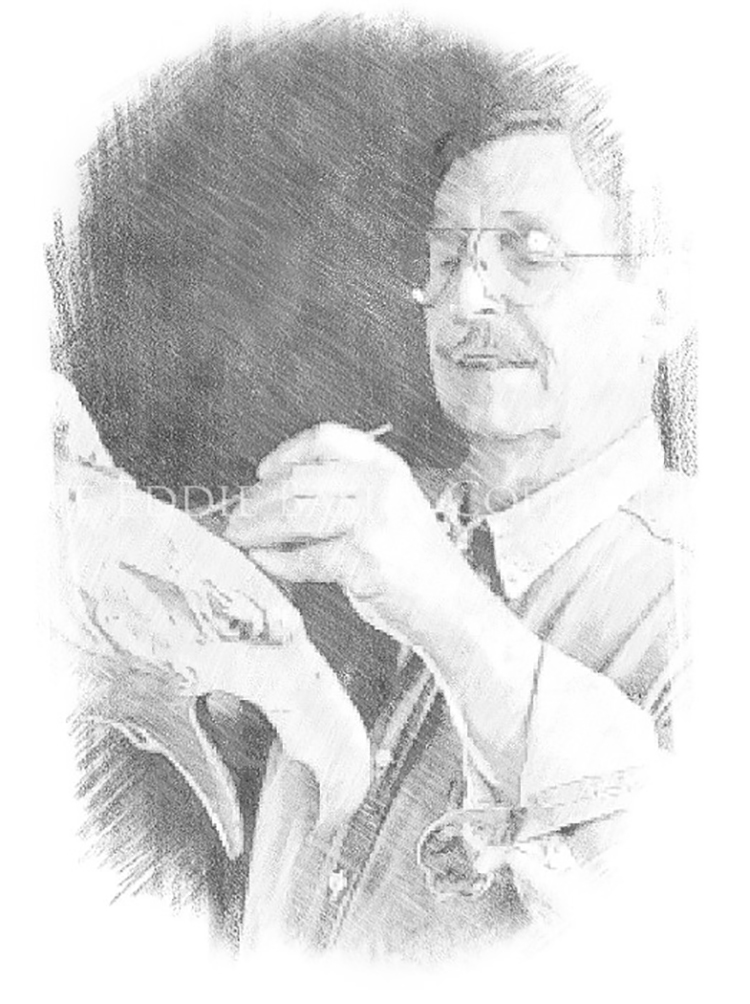
Fritz White, CA
(1930-2010)
Fritz White was best known throughout the world for his distinctive style of bronze sculpture, and for being a key player in turning Loveland into the well-known sculpture community it is today.
He was born January 14, 1930 in Milford, Ohio to Denver and Geneva (Hatfield) White. By the time he was 12, his father had enrolled him in an adult art class in a college in Cincinnati. “The war was going on and those small colleges needed all the students they could get, so they agreed to take me. I got a lot of special attention from the teachers. It was great,” he recalled.
After graduating from Terrace Park High School in Cincinnati in 1948, Fritz played semi-pro football. Carrying those lessons forward, he later coached junior high football and was fondly known as Coach Whitey.
Fritz proudly served in the U.S. Marine Corp. from 1948 to 1953 as Sergeant of a rifle platoon and later as a Gunny. Following his service, Fritz launched Fancy Lettering, a design studio for sales publications, and subsequently took a position with National Underwriter Company. On a whim in 1961, he loaded up his car with large chunks of marble from Marble, Colorado and thus began his long career in sculpture. Thanks to the support of his dear friend John J. McGraw, Fritz was soon working in clay and bronze.
A decade later, in the spring of 1972, Fritz was elected to the prestigious Cowboy Artists of America and became widely accepted as one of the finest sculptors of this century. In addition to winning several CAA awards for excellence (including the only sculptor to win the Colt Award), he served as board member, vice president and president. He was also a Fellow of the National Sculpture Society.
Source: Fritz White
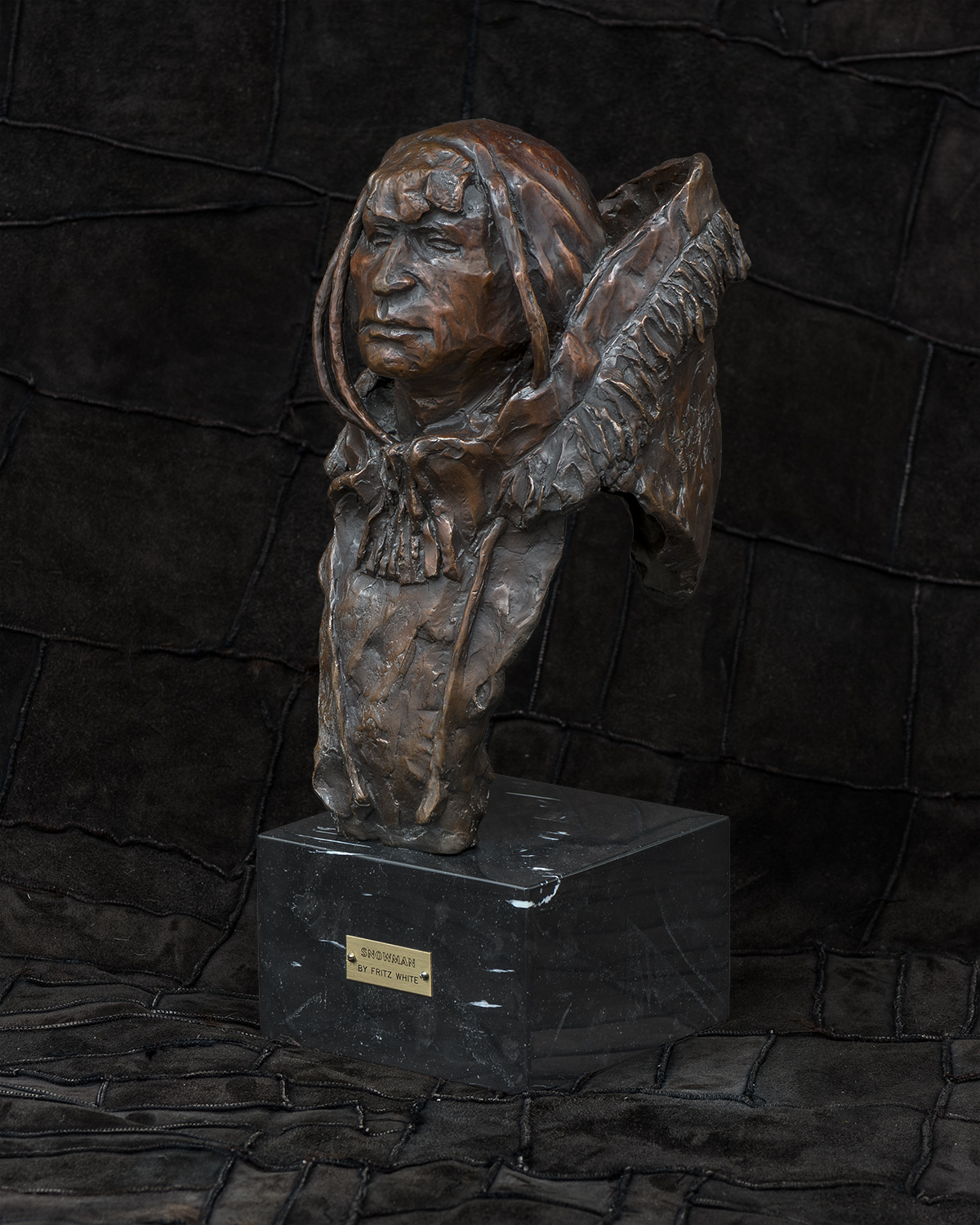
Snowman
Artist: Fritz White, CA (1930-2010)
Description: Bronze (1978) | Dimensions: 13”h x 8”w x 6”d; Edition of 25bronze
Cowboy Artists of America Member, Fritz White (1930-2010), sculpted “Snowman” in 1978. It is but one of many of bronze busts White depicted that demonstrates his skill and versatility in depicting indigenous peoples of diverse backgrounds. Regardless of culture or circumstance his subjects are placed in, White always presents his figures realistically and with great emotional impact. He is also adept at adding unique touches such as the hood to add another element of artistry.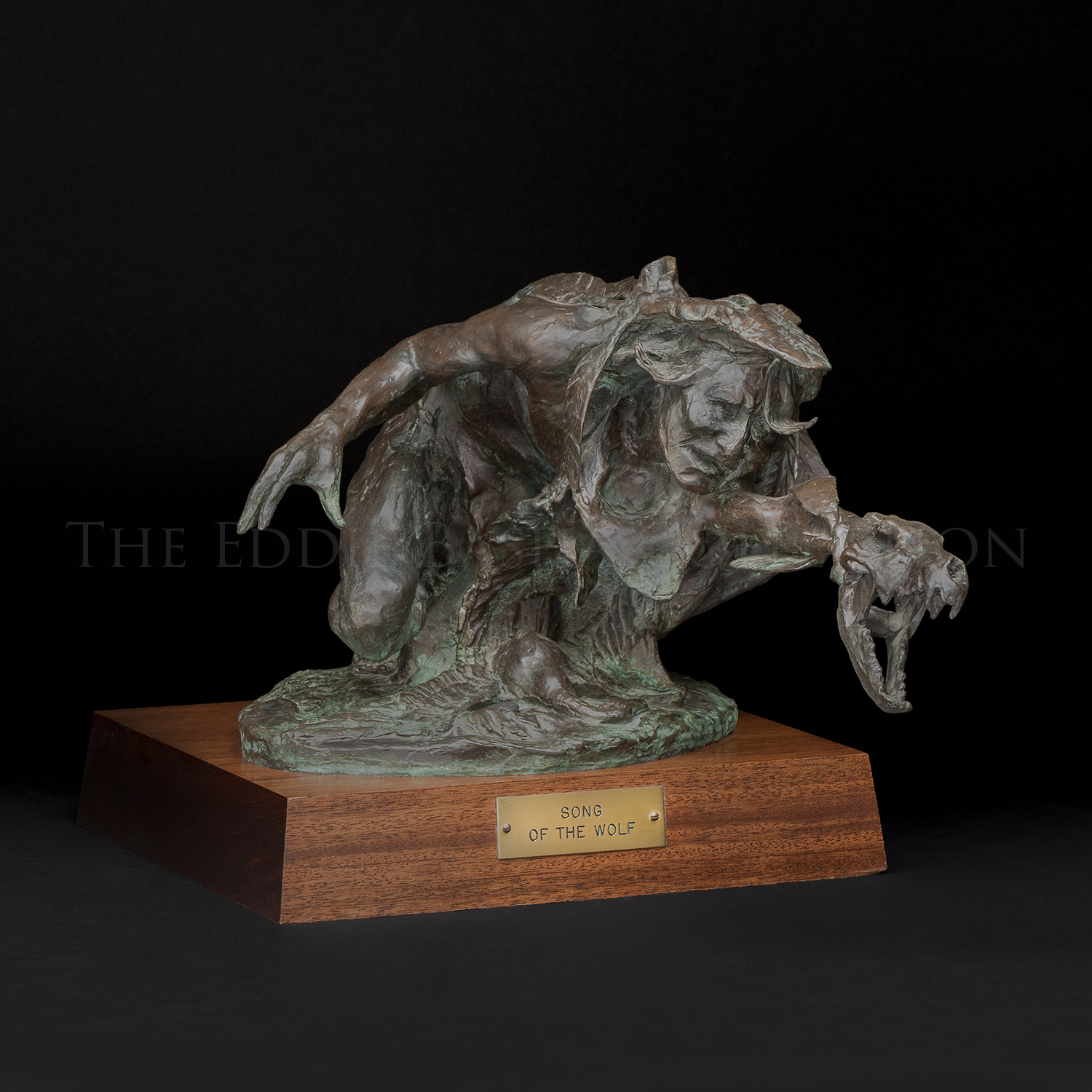
Song of the Wolf
Artist: Fritz White, CA (1930-2010)
Description: Bronze (1972) | Dimensions: 11”h x 11”w x 18”d; Edition #11 of 16bronze
Fritz White, the artist, Commentary: “I think about mystical things only about as often as anyone else. “Song of the Wolf” came along after I had done a dozen other pieces. It is strongly mystical. In the lights and shadows of the night fire, the dancer tells of the terrible elements, the lightning, the thunder, the hatred in the freezing sleet, the cold of the dying moon. He weaves a web around the fire, glides through the fire and becomes the terrible cat of long ago. He’s the great bear, the giant buffalo and when he crouches, like a shot, slams the gaping jaw before your eyes, he’s the very wolf at your door. He makes the other Indian bronzes true. Now we see the man and we know him!”
“Song of the Wolf” made its debut at the 8th Annual Cowboy Artists of America Exhibition & Sale, the first exhibition the group held at the Phoenix Art Museum.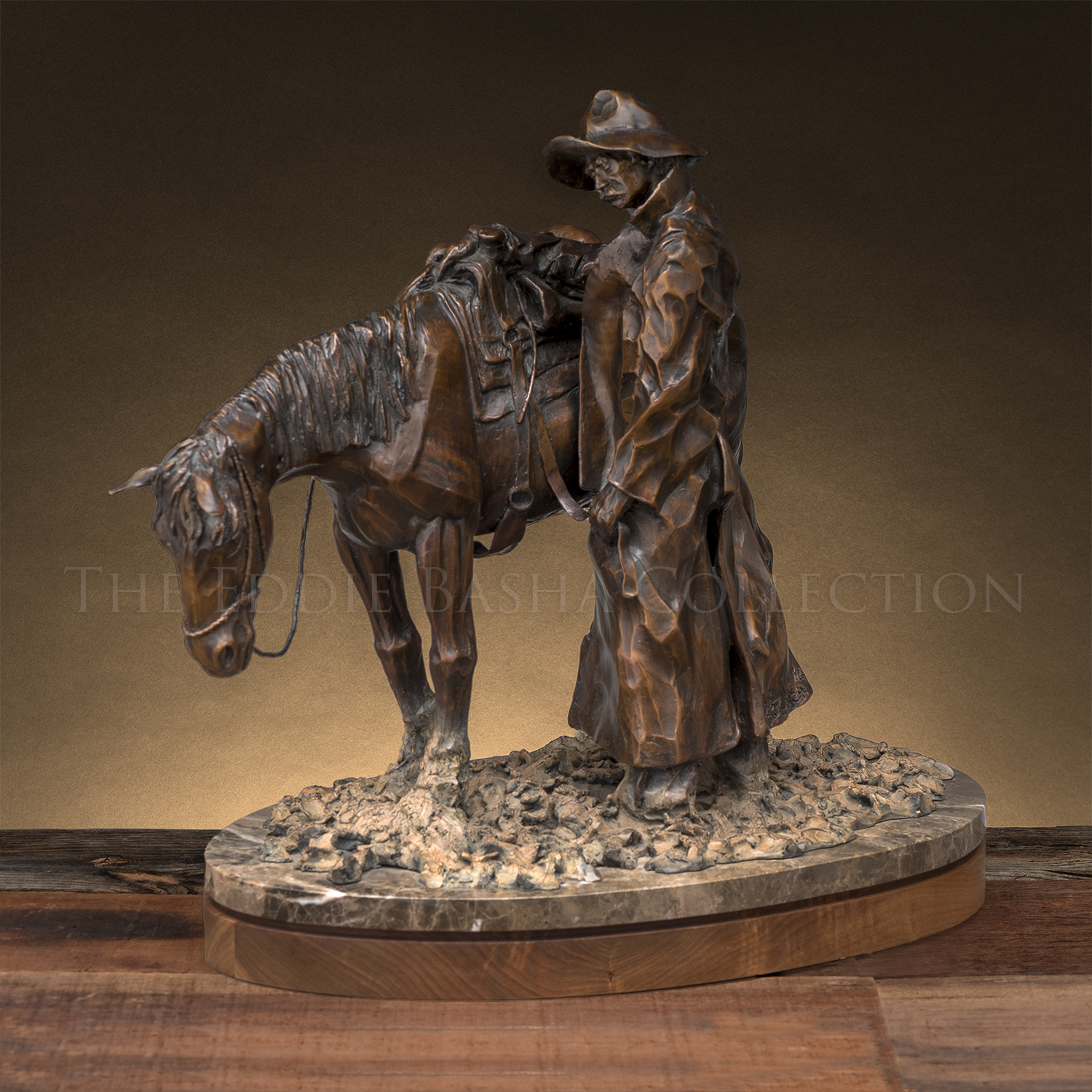
Just Plum Wore Out
Artist: Fritz White, CA (1930-2010)
Description: Bronze (2002) | Dimensions: 18 ½”h x 21 ½”w x 13d; Edition #1 of 24bronze
The weariness of both the horse and rider in this bronze sculpture is palpable. As its viewers, we can well imagine the many miles the two have traveled and the hardships they have endured; it is written in their posture, demeanor, and in their faces. White has done a masterful job of creating characters that pull at our emotions to create a sense of empathy with these two as they journey on.
At its debut at the 37th Annual Cowboy Artists of America Exhibition & Sale in 2002 at the Phoenix Art Museum, many were overhead commenting how well Fritz had portrayed the rider, his horse and the ground they covered as having seen better days.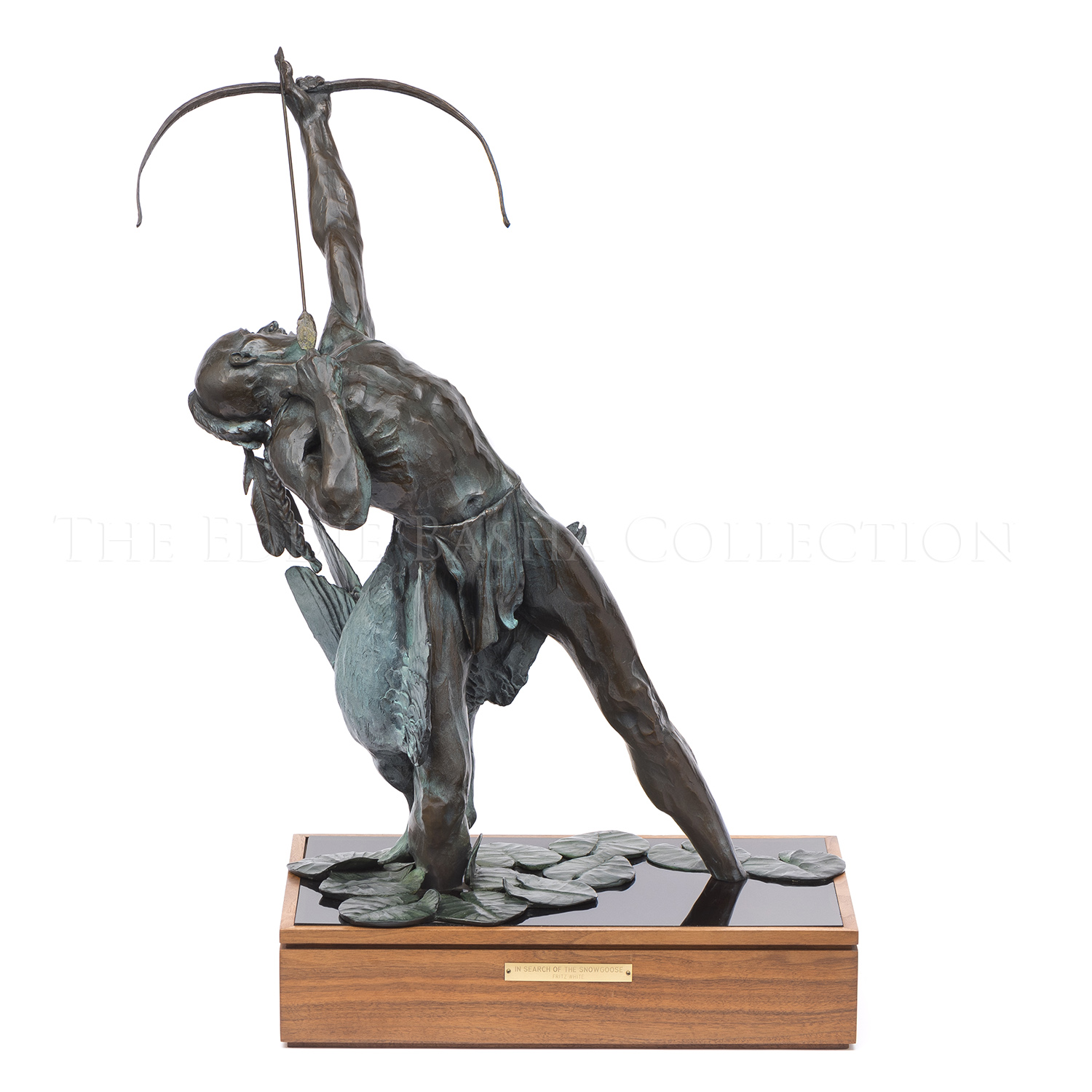
In Search of the Snow Goose
Artist: Fritz White, CA (1930-2010)
Description: Bronze (1985) | Dimensions: 32”h x 24 ¾”w x 16”d; Edition #10 of 16bronze
This is one of Fritz White’s best known and most successful works. He shows a sure handling of the human form and presents it in a dramatic way. The hunter presented becomes a symbol and an individual simultaneously. Among various tribal entities, the snow goose is symbolic of the reliability, ambition, tenacity and strong work ethic of masculine energy which this piece exudes. According to National Geographic, snow geese are harbingers of the changing seasons. They fly south for the winter in huge, honking flocks that may appear as a "V" formation or simply as a large "snowstorm" of white birds. They spend the colder seasons in southern coastal marshes, bays, wet grasslands, and fields.
“In Search of the Snow Goose” made its debut in 1985 at the 20th Annual Cowboy Artists of America Exhibition & Sale held at the Phoenix Art Museum. Not only did it capture the Gold Medal in sculpture that year, but White won the Colt Award, or Artists’ Choice Award, which is especially meaningful for its recipient as it is voted on by his peers for the best overall exhibition in a given year. The EBC is honored to have this piece in its permanent collection.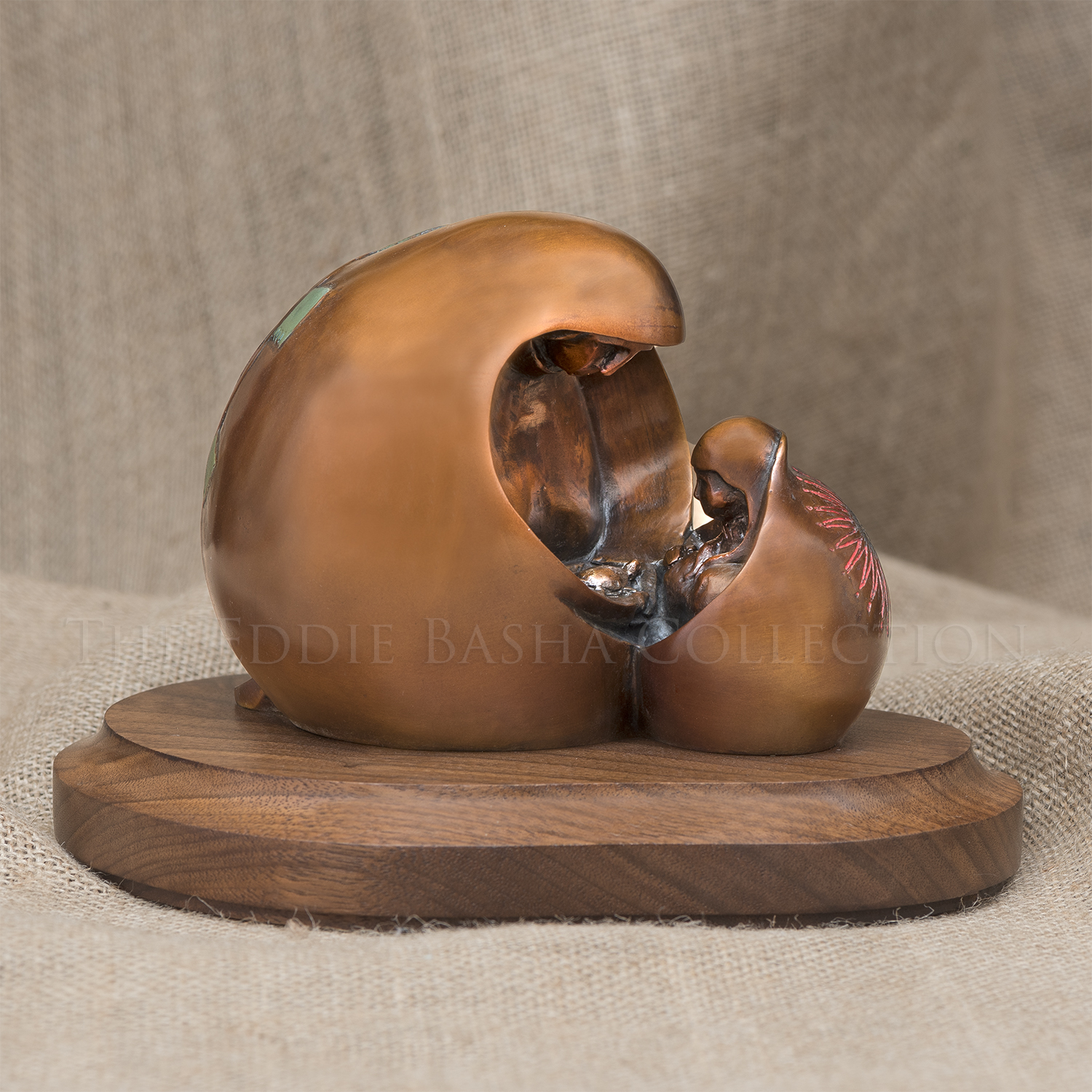
Grandmother’s, The Way of the Turtle
Artist: Fritz White, CA (1930-2010)
Description: Bronze | Dimensions: 9"h x 6 ¾”w x 6"dbronze
The turtle is a sacred creature among American Indian tribes. Each tribe’s cultural view of the turtle is slightly different. However, the deeper meaning remains the same: the turtle represents Uŋčí makȟá, Lakȟóta for Grandmother Earth, who teaches us to walk our paths in peace. To most tribes the turtle also represents healing, wisdom, spirituality, health, safety, longevity, protection, and fertility. Some believe that the turtle contributed to creation because the turtle dove into the primeval waters to retrieve mud to create Mother Earth. Additionally, the shell of the turtle represents protection and perseverance. (Source: Native Hope)
Fritz White began his grandmother series of bronzes in 1989 and continued producing at least one grandmother sculpture each year until his death. This particular piece made its debut at the 41st Annual CAA Exhibition & Sale in 2006 at the Phoenix Art Museum. White chose this subject because of the important roles that grandmothers play in American Indian cultures as well as others—as caregivers, as teachers, as advisors, and as models of behavior. Unlike his other sculptures in this series, White uses simple forms, such as circles, abstracted to their most basic shape and its surface is highly polished. The invocation of reverence is the intention of the piece rather than the depiction of a particular action.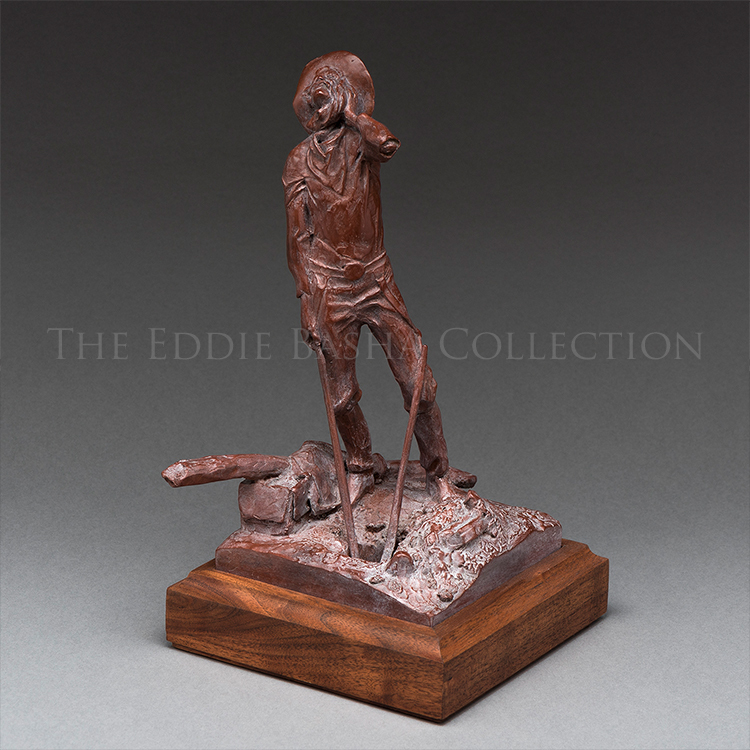
End of the Open Range
Artist: Fritz White, CA (1930-2010)
Description: Bronze (1994) | Dimensions: 11”h x 7 ½”w x 6”d; Edition #5 of 25bronze
Following the era of the great cattle drives that brought Texas beef first to the railheads in Kansas and then to the open plains of Montana shortly after the end of the civil war, ranches were established on what were once free ranges. Herds from different owners co-mingled in pastures. Annual round ups were organized in part to separate, according to brand, cows belonging to different operations. Eventually, communal grazing gave way to fenced in pastures. Fencing in much of the West was backbreaking work; the ground was hard and fencing material scarce which lead to the invention of barbed wire. That necessity presented cowboys and ranchers with yet another difficult task—building and maintaining the enclosures. Some say that the romance of the Old West began to fade when the open ranges were fenced. Fritz White presents that era succinctly in this bronze of a weary ranch hand, or possibly frontier farmer, going about the dreary task of building a fence.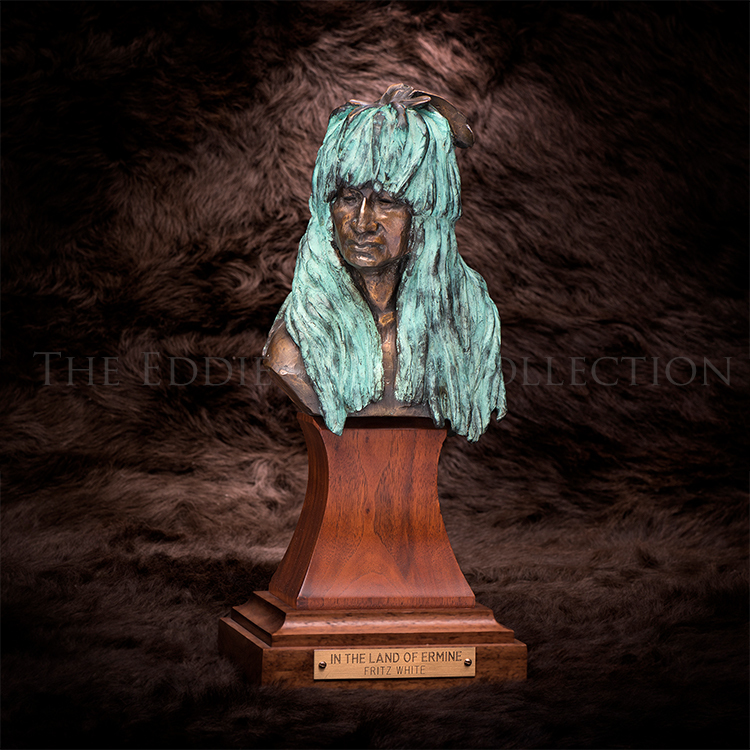
In the Land of Ermine
Artist: Fritz White, CA (1930-2010)
Description: Bronze | Dimensions: 8”h x 6”w x 4”d; Edition #18 of 50bronze
This small bronze bust is an example of Fritz White’s ability to capture faces realistically and impart an emotional impact to the viewer. The Indian shown here wears an elaborate headdress made up entirely of ermine skins which cover his head and shoulders. His face is turned downward and to his right. White was familiar with many Indian cultures and adept at capturing each.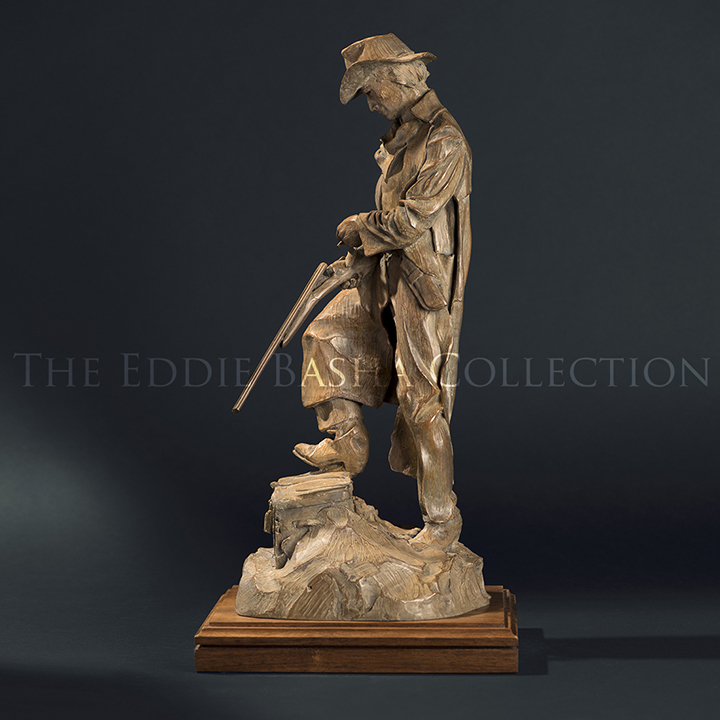
Jesse Tanner Rankin, Lawman
Artist: Fritz White, CA (1930-2010)
Description: Bronze (1999) | 18”h x 6 ½”w x 8 ¼”d; Edition #14 of 30bronze
 Bronze (1978) | Dimensions: 13”h x 8”w x 6”d; Edition of 25
Bronze (1978) | Dimensions: 13”h x 8”w x 6”d; Edition of 25Cowboy Artists of America Member, Fritz White (1930-2010), sculpted “Snowman” in 1978. It is but one of many of bronze busts White depicted that demonstrates his skill and versatility in depicting indigenous peoples of diverse backgrounds. Regardless of culture or circumstance his subjects are placed in, White always presents his figures realistically and with great emotional impact. He is also adept at adding unique touches such as the hood to add another element of artistry.
Snowman
Artist: Fritz White, CA (1930-2010)
Cowboy Artists of America Member, Fritz White (1930-2010), sculpted “Snowman” in 1978. It is but one of many of bronze busts White depicted that demonstrates his skill and versatility in depicting indigenous peoples of diverse backgrounds. Regardless of culture or circumstance his subjects are placed in, White always presents his figures realistically and with great emotional impact. He is also adept at adding unique touches such as the hood to add another element of artistry.
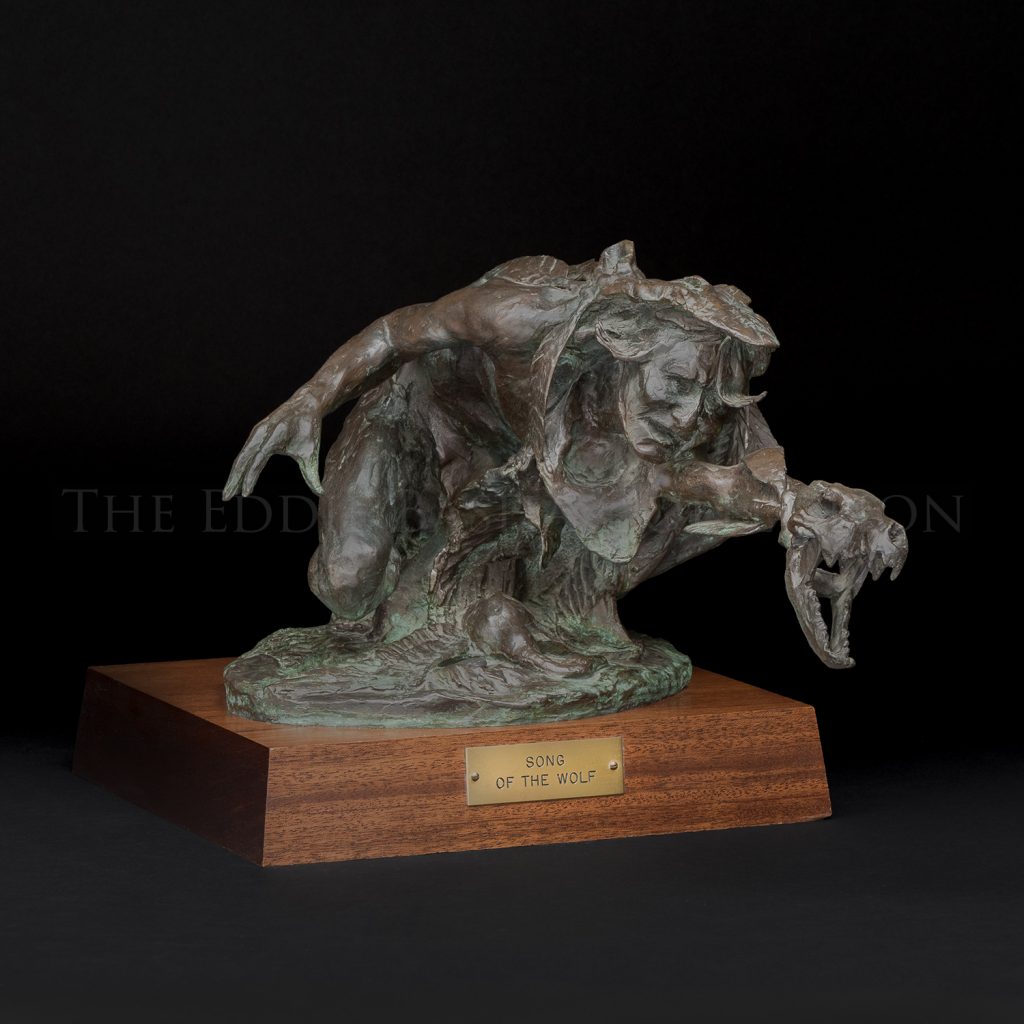 Bronze (1972) | Dimensions: 11”h x 11”w x 18”d; Edition #11 of 16
Bronze (1972) | Dimensions: 11”h x 11”w x 18”d; Edition #11 of 16Fritz White, the artist, Commentary: “I think about mystical things only about as often as anyone else. “Song of the Wolf” came along after I had done a dozen other pieces. It is strongly mystical. In the lights and shadows of the night fire, the dancer tells of the terrible elements, the lightning, the thunder, the hatred in the freezing sleet, the cold of the dying moon. He weaves a web around the fire, glides through the fire and becomes the terrible cat of long ago. He’s the great bear, the giant buffalo and when he crouches, like a shot, slams the gaping jaw before your eyes, he’s the very wolf at your door. He makes the other Indian bronzes true. Now we see the man and we know him!”
“Song of the Wolf” made its debut at the 8th Annual Cowboy Artists of America Exhibition & Sale, the first exhibition the group held at the Phoenix Art Museum.
Song of the Wolf
Artist: Fritz White, CA (1930-2010)
Fritz White, the artist, Commentary: “I think about mystical things only about as often as anyone else. “Song of the Wolf” came along after I had done a dozen other pieces. It is strongly mystical. In the lights and shadows of the night fire, the dancer tells of the terrible elements, the lightning, the thunder, the hatred in the freezing sleet, the cold of the dying moon. He weaves a web around the fire, glides through the fire and becomes the terrible cat of long ago. He’s the great bear, the giant buffalo and when he crouches, like a shot, slams the gaping jaw before your eyes, he’s the very wolf at your door. He makes the other Indian bronzes true. Now we see the man and we know him!”
“Song of the Wolf” made its debut at the 8th Annual Cowboy Artists of America Exhibition & Sale, the first exhibition the group held at the Phoenix Art Museum.
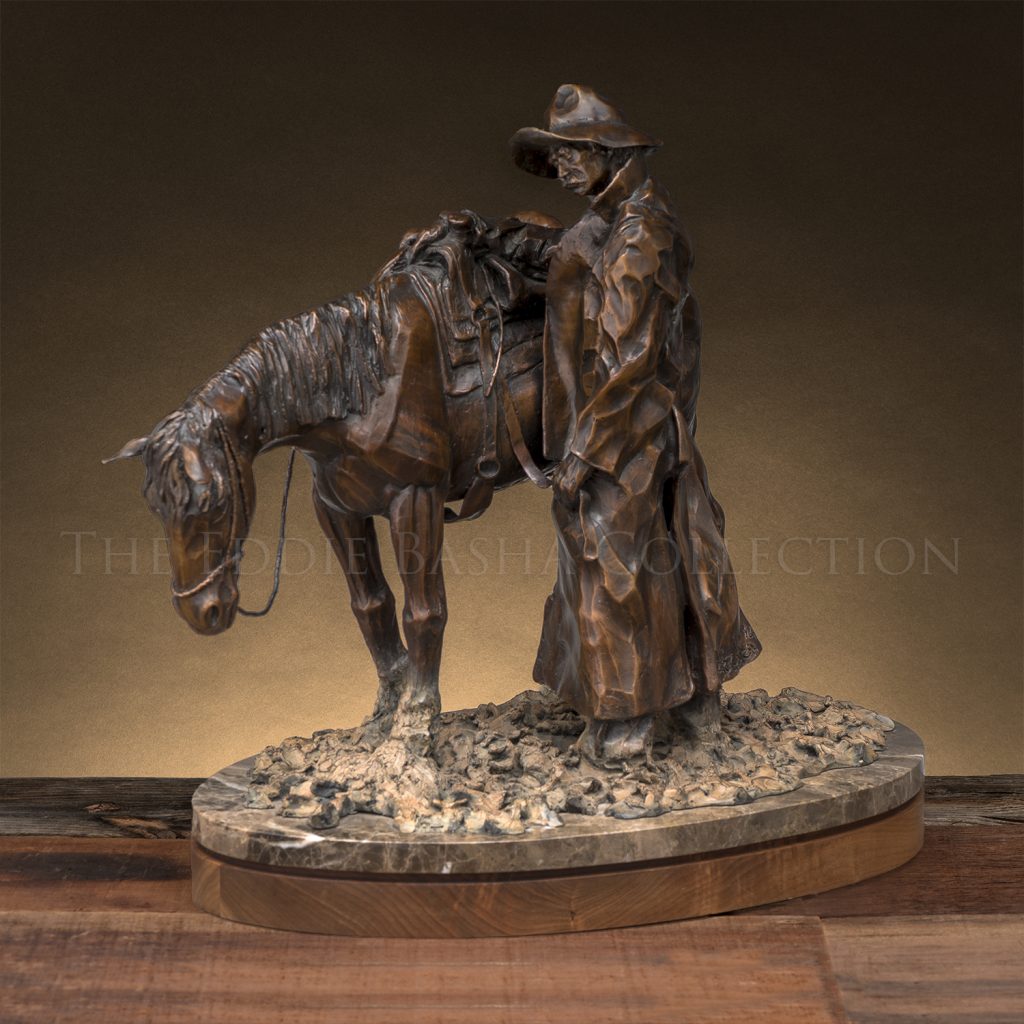 Bronze (2002) | Dimensions: 18 ½”h x 21 ½”w x 13d; Edition #1 of 24
Bronze (2002) | Dimensions: 18 ½”h x 21 ½”w x 13d; Edition #1 of 24The weariness of both the horse and rider in this bronze sculpture is palpable. As its viewers, we can well imagine the many miles the two have traveled and the hardships they have endured; it is written in their posture, demeanor, and in their faces. White has done a masterful job of creating characters that pull at our emotions to create a sense of empathy with these two as they journey on.
At its debut at the 37th Annual Cowboy Artists of America Exhibition & Sale in 2002 at the Phoenix Art Museum, many were overhead commenting how well Fritz had portrayed the rider, his horse and the ground they covered as having seen better days.
Just Plum Wore Out
Artist: Fritz White, CA (1930-2010)
The weariness of both the horse and rider in this bronze sculpture is palpable. As its viewers, we can well imagine the many miles the two have traveled and the hardships they have endured; it is written in their posture, demeanor, and in their faces. White has done a masterful job of creating characters that pull at our emotions to create a sense of empathy with these two as they journey on.
At its debut at the 37th Annual Cowboy Artists of America Exhibition & Sale in 2002 at the Phoenix Art Museum, many were overhead commenting how well Fritz had portrayed the rider, his horse and the ground they covered as having seen better days.
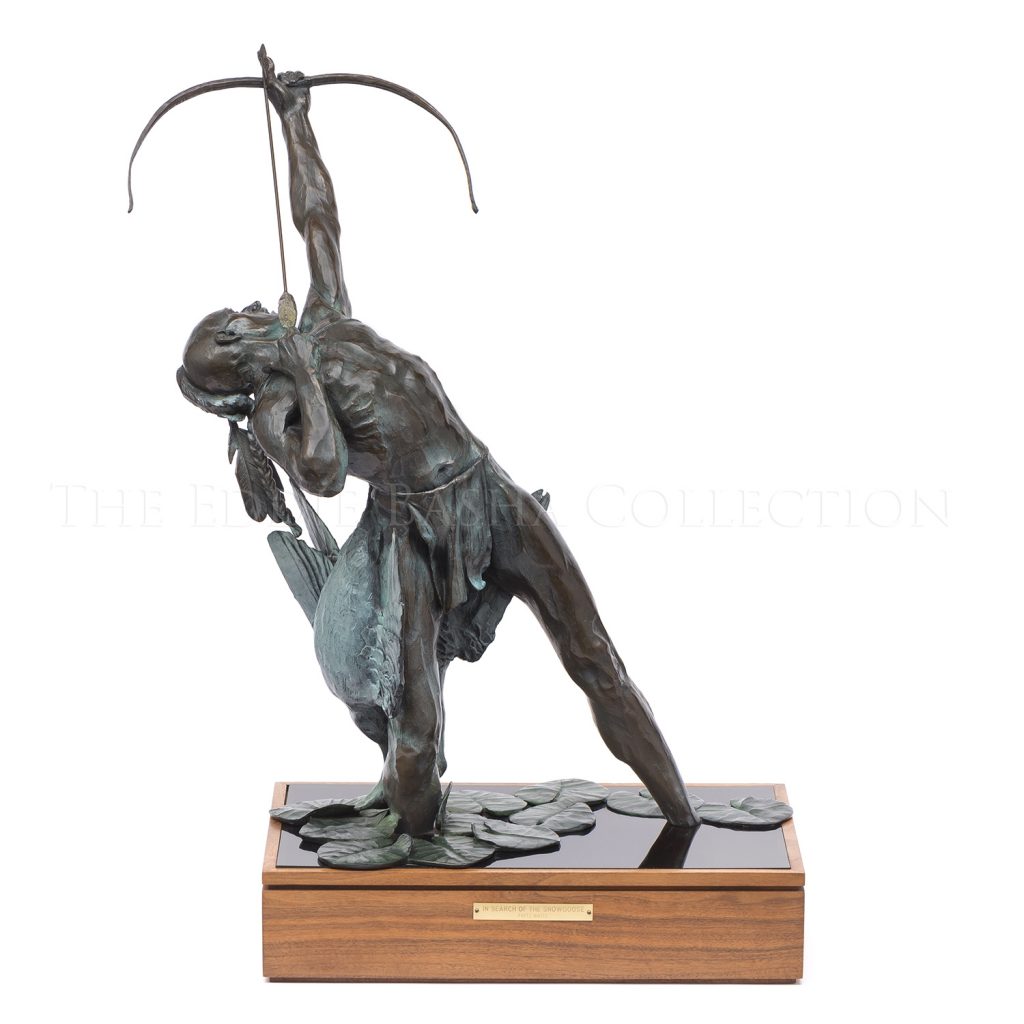 Bronze (1985) | Dimensions: 32”h x 24 ¾”w x 16”d; Edition #10 of 16
Bronze (1985) | Dimensions: 32”h x 24 ¾”w x 16”d; Edition #10 of 16This is one of Fritz White’s best known and most successful works. He shows a sure handling of the human form and presents it in a dramatic way. The hunter presented becomes a symbol and an individual simultaneously. Among various tribal entities, the snow goose is symbolic of the reliability, ambition, tenacity and strong work ethic of masculine energy which this piece exudes. According to National Geographic, snow geese are harbingers of the changing seasons. They fly south for the winter in huge, honking flocks that may appear as a "V" formation or simply as a large "snowstorm" of white birds. They spend the colder seasons in southern coastal marshes, bays, wet grasslands, and fields.
“In Search of the Snow Goose” made its debut in 1985 at the 20th Annual Cowboy Artists of America Exhibition & Sale held at the Phoenix Art Museum. Not only did it capture the Gold Medal in sculpture that year, but White won the Colt Award, or Artists’ Choice Award, which is especially meaningful for its recipient as it is voted on by his peers for the best overall exhibition in a given year. The EBC is honored to have this piece in its permanent collection.
In Search of the Snow Goose
Artist: Fritz White, CA (1930-2010)
This is one of Fritz White’s best known and most successful works. He shows a sure handling of the human form and presents it in a dramatic way. The hunter presented becomes a symbol and an individual simultaneously. Among various tribal entities, the snow goose is symbolic of the reliability, ambition, tenacity and strong work ethic of masculine energy which this piece exudes. According to National Geographic, snow geese are harbingers of the changing seasons. They fly south for the winter in huge, honking flocks that may appear as a "V" formation or simply as a large "snowstorm" of white birds. They spend the colder seasons in southern coastal marshes, bays, wet grasslands, and fields.
“In Search of the Snow Goose” made its debut in 1985 at the 20th Annual Cowboy Artists of America Exhibition & Sale held at the Phoenix Art Museum. Not only did it capture the Gold Medal in sculpture that year, but White won the Colt Award, or Artists’ Choice Award, which is especially meaningful for its recipient as it is voted on by his peers for the best overall exhibition in a given year. The EBC is honored to have this piece in its permanent collection.
 Bronze | Dimensions: 9"h x 6 ¾”w x 6"d
Bronze | Dimensions: 9"h x 6 ¾”w x 6"d The turtle is a sacred creature among American Indian tribes. Each tribe’s cultural view of the turtle is slightly different. However, the deeper meaning remains the same: the turtle represents Uŋčí makȟá, Lakȟóta for Grandmother Earth, who teaches us to walk our paths in peace. To most tribes the turtle also represents healing, wisdom, spirituality, health, safety, longevity, protection, and fertility. Some believe that the turtle contributed to creation because the turtle dove into the primeval waters to retrieve mud to create Mother Earth. Additionally, the shell of the turtle represents protection and perseverance. (Source: Native Hope)
Fritz White began his grandmother series of bronzes in 1989 and continued producing at least one grandmother sculpture each year until his death. This particular piece made its debut at the 41st Annual CAA Exhibition & Sale in 2006 at the Phoenix Art Museum. White chose this subject because of the important roles that grandmothers play in American Indian cultures as well as others—as caregivers, as teachers, as advisors, and as models of behavior. Unlike his other sculptures in this series, White uses simple forms, such as circles, abstracted to their most basic shape and its surface is highly polished. The invocation of reverence is the intention of the piece rather than the depiction of a particular action.
Grandmother’s, The Way of the Turtle
Artist: Fritz White, CA (1930-2010)
The turtle is a sacred creature among American Indian tribes. Each tribe’s cultural view of the turtle is slightly different. However, the deeper meaning remains the same: the turtle represents Uŋčí makȟá, Lakȟóta for Grandmother Earth, who teaches us to walk our paths in peace. To most tribes the turtle also represents healing, wisdom, spirituality, health, safety, longevity, protection, and fertility. Some believe that the turtle contributed to creation because the turtle dove into the primeval waters to retrieve mud to create Mother Earth. Additionally, the shell of the turtle represents protection and perseverance. (Source: Native Hope)
Fritz White began his grandmother series of bronzes in 1989 and continued producing at least one grandmother sculpture each year until his death. This particular piece made its debut at the 41st Annual CAA Exhibition & Sale in 2006 at the Phoenix Art Museum. White chose this subject because of the important roles that grandmothers play in American Indian cultures as well as others—as caregivers, as teachers, as advisors, and as models of behavior. Unlike his other sculptures in this series, White uses simple forms, such as circles, abstracted to their most basic shape and its surface is highly polished. The invocation of reverence is the intention of the piece rather than the depiction of a particular action.
 Bronze (1994) | Dimensions: 11”h x 7 ½”w x 6”d; Edition #5 of 25
Bronze (1994) | Dimensions: 11”h x 7 ½”w x 6”d; Edition #5 of 25Following the era of the great cattle drives that brought Texas beef first to the railheads in Kansas and then to the open plains of Montana shortly after the end of the civil war, ranches were established on what were once free ranges. Herds from different owners co-mingled in pastures. Annual round ups were organized in part to separate, according to brand, cows belonging to different operations. Eventually, communal grazing gave way to fenced in pastures. Fencing in much of the West was backbreaking work; the ground was hard and fencing material scarce which lead to the invention of barbed wire. That necessity presented cowboys and ranchers with yet another difficult task—building and maintaining the enclosures. Some say that the romance of the Old West began to fade when the open ranges were fenced. Fritz White presents that era succinctly in this bronze of a weary ranch hand, or possibly frontier farmer, going about the dreary task of building a fence.
End of the Open Range
Artist: Fritz White, CA (1930-2010)
Following the era of the great cattle drives that brought Texas beef first to the railheads in Kansas and then to the open plains of Montana shortly after the end of the civil war, ranches were established on what were once free ranges. Herds from different owners co-mingled in pastures. Annual round ups were organized in part to separate, according to brand, cows belonging to different operations. Eventually, communal grazing gave way to fenced in pastures. Fencing in much of the West was backbreaking work; the ground was hard and fencing material scarce which lead to the invention of barbed wire. That necessity presented cowboys and ranchers with yet another difficult task—building and maintaining the enclosures. Some say that the romance of the Old West began to fade when the open ranges were fenced. Fritz White presents that era succinctly in this bronze of a weary ranch hand, or possibly frontier farmer, going about the dreary task of building a fence.
 Bronze | Dimensions: 8”h x 6”w x 4”d; Edition #18 of 50
Bronze | Dimensions: 8”h x 6”w x 4”d; Edition #18 of 50This small bronze bust is an example of Fritz White’s ability to capture faces realistically and impart an emotional impact to the viewer. The Indian shown here wears an elaborate headdress made up entirely of ermine skins which cover his head and shoulders. His face is turned downward and to his right. White was familiar with many Indian cultures and adept at capturing each.
In the Land of Ermine
Artist: Fritz White, CA (1930-2010)
This small bronze bust is an example of Fritz White’s ability to capture faces realistically and impart an emotional impact to the viewer. The Indian shown here wears an elaborate headdress made up entirely of ermine skins which cover his head and shoulders. His face is turned downward and to his right. White was familiar with many Indian cultures and adept at capturing each.